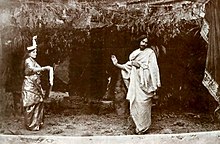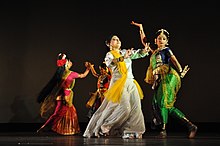
Back رابيندرا سانجيت Arabic রবীন্দ্রসঙ্গীত Bengali/Bangla रवींद्र संगीत Hindi Rabindra Sangeet ID രബീന്ദ്ര സംഗീത് Malayalam रवीन्द्र सङ्गीत Nepali ਰਬਿੰਦਰ ਸੰਗੀਤ Punjabi ரவீந்திர சங்கீதம் Tamil
| Rabindra Sangeet | |
|---|---|
| by Rabindranath Tagore | |
 | |
| Native name | রবীন্দ্রসঙ্গীত |
| Composed | 1875–1941 |
Rabindra Sangeet (Bengali: রবীন্দ্র সঙ্গীত; pronounced [robindɾo ʃoŋɡit]), also known as Tagore Songs, are songs from the Indian subcontinent written and composed by the Bengali polymath Rabindranath Tagore, winner of the 1913 Nobel Prize in Literature,[1] the first Indian[2] and also the first non-European to receive such recognition.[3] Tagore was a prolific composer with approximately 2,232 songs to his credit.[4] The songs have distinctive characteristics in the music of Bengal, popular in India and Bangladesh.[5][6]

It is characterised by its distinctive rendition while singing which, includes a significant amount of ornamentation like meend, murki, etc. and is filled with expressions of romanticism. The music is mostly based on Hindustani classical music, Carnatic music, Western tunes and the traditional folk music of Bengal and inherently possess within them, a perfect balance, an endearing economy of poetry and musicality.[peacock prose] Lyrics and music both hold almost equal importance in Rabindra Sangeet.[citation needed] Tagore created some six new taals, inspired by Carnatic talas, because he felt the traditional taals existing at the time could not do justice and were coming in the way of the seamless narrative of the lyrics.[citation needed]
- ^ Sigi 2006, p. 90
- ^ Rekha Sigi (2006). Gurudev Ravindra Nath Tagore A Biography. Diamond Pocket Books (P) Ltd. p. 80. ISBN 978-81-89182-90-8.
- ^ Paul, Samiran Kumar; Prasad, Amar Nath (2006). Recritiquing Rabindranath Tagore (1st ed.). New Delhi: Sarup & Sons. ISBN 81-7625-661-7. OCLC 297209437.
- ^ Sanjukta Dasgupta; Chinmoy Guha (2013). Tagore-At Home in the World. SAGE Publications. p. 254. ISBN 978-81-321-1084-2.
- ^ Tagore 2007, p. xii
- ^ "Magic of Rabindra Sangeet". Deccan Herald. Archived from the original on 27 September 2013. Retrieved 9 July 2013.